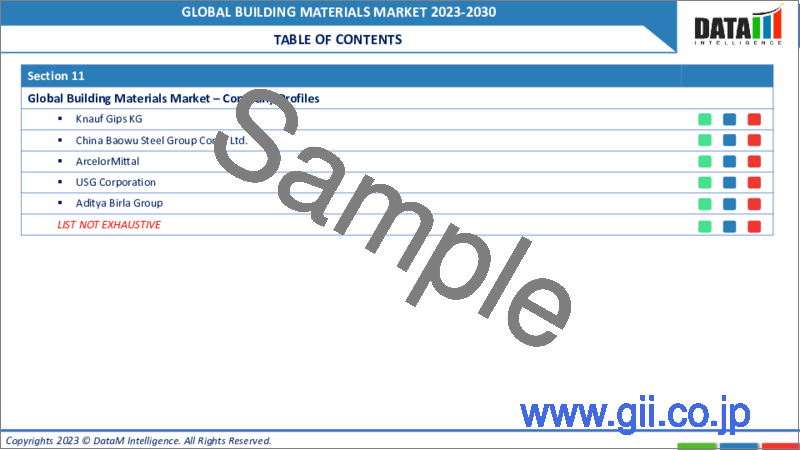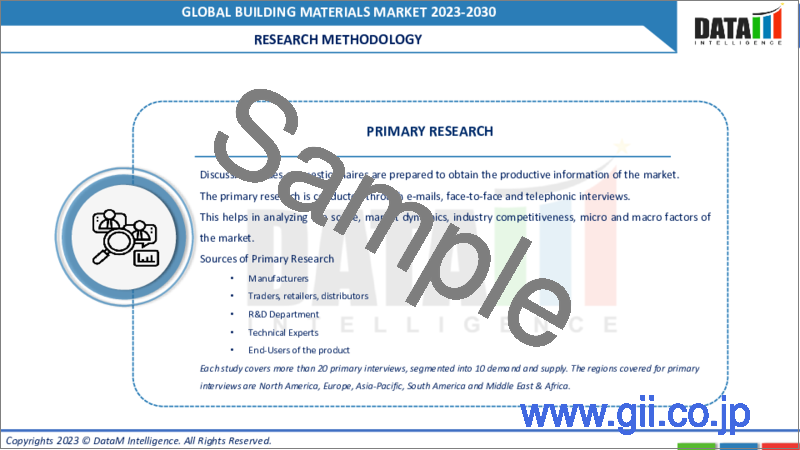|
|
市場調査レポート
商品コード
1290384
建築材料の世界市場-2023-2030Global Building Materials Market - 2023-2030 |
||||||
カスタマイズ可能
適宜更新あり
|
|||||||
| 建築材料の世界市場-2023-2030 |
|
出版日: 2023年06月12日
発行: DataM Intelligence
ページ情報: 英文 207 Pages
納期: 即日から翌営業日
|
- 全表示
- 概要
- 目次
市場概要
建築材料の世界市場は、2022年に1兆3,000億米ドルに達し、2023年から2030年の予測期間中にCAGR 3.9%で成長し、2030年には1兆7,000億米ドルに達すると予測されています。
予測期間中、建設業界の急速な拡大が世界の建築材料需要を押し上げると予想されます。消費者や開発者が、手頃な価格で環境に優しく、エネルギー効率の高い住宅に重点を置いていることから、建設業界は大きな需要を経験すると予測されています。最近の世界の危機に対する救済策として、政府がエネルギー効率とグリーン建設に力を入れるようになったことが、製品需要に影響を及ぼすと予想されます。
米国グリーン建設評議会(USGBC)は、グリーン建設規則を採用したカナダ、中国、インド、ブラジル、韓国に対して認証を付与しました。米国と欧州連合がグリーン建設規則を採用したことで、おそらく他の国々も二酸化炭素排出量削減のために同様の規則を採用するようになり、世界の建築材料市場の成長を促進することになるでしょう。
市場力学
グリーン建築材料に対する需要の高まり
環境に対する関心が高まり、建築資材の需要が高まることで、市場の拡大が見込まれます。建物の持続可能性と効率性は、グリーン建築材料を使用することで向上させることができます。同種の製品に比べ、二酸化炭素の排出量が少なく、水の消費量も少なく、メンテナンスが簡単だからです。また、持続可能でエネルギー効率に優れているため、維持管理が容易で経済的です。
先進国の政府もグリーンビルディングを推進するためのインセンティブや法律を導入しており、建築材料の需要拡大が期待されます。例えば、米国、スペイン、シンガポール、ニュージーランドでは、環境に配慮した住宅建築のためのインセンティブが存在します。このような取り組みにより、世界の建築材料市場が活性化すると期待されています。
リノベーションの増加
建築・建設業界では、修理や改修のプロジェクトが大きく伸びています。それは、外観のファッション動向の変化、現代的なモジュラーアーキテクチャ、収入の増加といったことが理由です。住宅改修プロジェクトの必要性、建設工事、都市化などの理由から、住宅と商業の両分野で、改修活動が大幅に増加しています。
例えば、Make in Indiaプログラムによると、連邦電力大臣は2021年から2022年にかけて、ウッタラカンド州の478の学校と8つの地区におけるリハビリテーションと修復プロジェクトのために22.5クローを承認しました。建築用引張構造、グリーンルーフィング、キャノピーなどにおける建築用ファブリックの使用は増加しています。リフォームやリノベーションのプロジェクトが増える中、世界の建築材料市場を牽引する要素となっています。
環境規制とサステナビリティへの懸念
建設業界を規制するために設けられた多くの規制は、世界の建築材料市場に影響を与える最大の障害の一つです。低エネルギー建築物の建設と維持は、カリブ海地域で使用されているカリコム地域エネルギー効率建築基準(CREEBC)などの建築エネルギー基準によって義務付けられています。計画認可を受けるためには、建物は、エネルギー規範、材料のカーボンフットプリント、統合設計などに対応した規制に準拠する必要があります。
英国のThe Construction(Design and Management)Regulations 2015のような他の法律は、危険性を特定し、認識されたリスクを低減するための措置が取られるようにするために、共同リスク管理法を採用しています。これらの安全衛生法は人々の福祉に欠かせないものですが、建築業界には厳しい制約や圧力がかかり、市場の拡大が鈍化しています。
COVID-19の影響分析
COVID-19の流行により建築材料の需要パターンが変化し、世界の建築材料市場に大きな影響を与えました。自宅で仕事をすることを好み、そこで過ごす時間が長くなる人が増えたため、住宅リフォームの需要が増加しました。一方、そうした地域での活動が減少したため、病院、小売、オフィスビルなどの業界では資材需要が減少しました。
また、輸入にも問題が生じるため、さまざまな価格変動が予想されます。しかし、長期的なサプライチェーンの問題は、建設・建築資材の価格上昇につながる可能性があります。建設会社は、世界の需要増に伴い、通常業務の再開を目指すため、サプライチェーンのボトルネックに遭遇する可能性があります。
ロシア・ウクライナ紛争影響分析
ロシアとウクライナの紛争の結果、世界的に建築資材の不足が発生しています。産業の主要な要素は、原材料、労働力、エネルギー、商品です。ロシアとウクライナはその主要な輸出国であり、その結果、世界的に原材料が不足しています。ニッケル、銅、鉄などの金属は、ロシアとウクライナが世界的に大量に生産しています。
また、戦争によって、世界中の鉄鋼生産がストップしています。その結果、アルコパネル、金物、衛生用品、電気製品の製造に影響を及ぼしています。ロシアは世界の針葉樹の20%を供給しているため、戦争によって木材製品、木材パルプ、針葉樹、ブナ材、オーク材、チップボード、MDFの価格が上昇しました。
AIによる影響分析
建築材料の設計は、人工知能(AI)により進歩の余地があります。エンジニアや建築家は、AIのサポートにより、より効果的で経済的、かつ生態系に配慮した材料を製造することができます。材料の使用量を最大化することで、AI主導の設計は建築物の環境への影響を軽減することができます。
AI駆動設計は、エンジニアや建築家がより長持ちし、耐久性のある材料を作ることを支援することができます。また、AIを活用した設計は、建築プロセスにおけるエネルギー消費を最小限に抑えることができます。よりエネルギー効率の高い材料を開発するために、AIベースのアルゴリズムを使用して、さまざまな材料の特性など、多数のソースからデータを分析することができます。
目次
第1章 調査手法とスコープ
- 調査手法
- 調査目的および調査範囲
第2章 定義と概要
第3章 エグゼクティブサマリー
- 市場内訳:タイプ別
- 市場内訳:エンドユーザー別
- 市場内訳:地域別
第4章 市場力学
- 影響要因
- 促進要因
- 革新的な材料への需要
- 商業・インフラ分野の急速な拡大
- グリーン建築材料の需要拡大
- リノベーションの増加
- 抑制要因
- 環境規制とサステイナビリティへの懸念
- 材料価格の変動
- 機会
- 影響分析
- 促進要因
第5章 産業分析
- ポーターのファイブフォース分析
- サプライチェーン分析
- 価格分析
- 法規制の分析
第6章 COVID-19の分析
第7章 タイプ別
- 建設用骨材
- セメント
- コンクリート煉瓦
- 金属
- その他
第8章 エンドユーザー別
- 住宅
- 商業
- インフラ
- 工業
第9章 地域別
- 北米
- 米国
- カナダ
- メキシコ
- 欧州
- ドイツ
- 英国
- フランス
- イタリア
- スペイン
- その他欧州
- 南米
- ブラジル
- アルゼンチン
- その他南米地域
- アジア太平洋地域
- 中国
- インド
- 日本
- オーストラリア
- その他アジア太平洋地域
- 中東・アフリカ地域
第10章 競合情勢
- 競合シナリオ
- 市況/シェア分析
- M&A(合併・買収)分析
第11章 企業プロファイル
- CEMEX
- 会社概要
- 製品ポートフォリオと説明
- 主なハイライト
- 財務概要
- China National Building Material Company
- Lafarge Holcim
- Boral Limited
- Buzzi Unicem SpA
- Dyckerhoff AG
- CRH Plc
- CSR Limited
- Aditya Birla Group
- Ambuja Cements
第12章 付録
Market Overview
The Global Building Materials Market reached US$ 1.3 trillion in 2022 and is expected to reach US$ 1.7 trillion by 2030 growing with a CAGR of 3.9% during the forecast period 2023-2030.
During the forecast period, the construction industry's rapid expansion is expected to boost demand for global building materials. Given that consumers and developers are putting a strong emphasis on affordable, environmentally friendly and energy-efficient houses, the construction sector is predicted to experience significant demand. The government's increased focus on energy efficiency and green construction as a remedy to the recent global crisis is expected to have an impact on product demand.
The U.S. Green construction Council (USGBC) granted certification to Canada, China, India, Brazil and South Korea for adopting green construction rules. The U.S. and the European Union's adoption of green construction regulations will probably encourage other nations to do the same in an effort to cut carbon emissions, which will fuel the growth of the global building materials market.
Market Dynamics
Rising Demand for Green Building Materials
The market is expected to grow as a result of the increasing concerns about the environment, which will boost demand for building materials. A building's sustainability and efficiency can be improved by using green building materials. It is because they generate fewer carbon emissions, consume less water and are simpler to maintain than comparable products. They are also easy to maintain and economical because they are sustainable and energy-efficient.
Governments in industrialized countries have also introduced incentives and legislation to promote green building, which is expected to increase demand for building materials. For instance, incentives for the construction of green residential buildings exist in U.S., Spain, Singapore and New Zealand. The initiatives are expected to boost the global building materials market.
Rising Renovations
In the building and construction industry, repair and renovation projects have grown significantly. It is because of things like changing fashion trends in terms of look, contemporary modular architecture and increased income. Due to reasons like the need for home improvement projects, construction work and urbanization, both the residential and commercial sectors have experienced substantial increases in renovation activity.
For instance, the Union Minister of Power approved 22.5 crores for rehabilitation and restoration projects in 478 schools and 8 districts of Uttarakhand in 2021-2022, according to the Make in India program. The use of construction fabrics in architecture tensile structures, green roofing, canopies and other applications are increasing. It is a driving component of the global building materials market as there are more renovation and remodeling projects being undertaken.
Environmental Regulations and Sustainability Concerns
Many regulations set in place to regulate the construction industry are one of the biggest obstacles affecting the global building materials market. Construction and maintenance of low-energy buildings are mandated by building energy codes, such as the CARICOM Regional Energy Efficiency Building Code (CREEBC), which is used in the Caribbean. For planning authorization, a building must comply with the regulations, which address energy norms, carbon footprints of materials, integrated design and more.
Other laws, like UK's The Construction (Design and Management) Regulations 2015, employ a collaborative risk management method to identify hazards and make sure that measures are taken to reduce recognized risks. Although these health and safety laws are crucial for people's welfare, they impose severe constraints and pressure on the building industry, which slows the expansion of the market.
COVID-19 Impact Analysis
Building materials demand patterns have shifted as a result of the COVID-19 epidemic, which has had significant impacts on the global building materials market. The demand for home remodeling projects increased as more people preferred to work from home and spent more time there. On the other hand, because of the decline in activity in such areas, the demand for materials fell in industries including hospitality, retail and office buildings.
Imports will also experience problems at this time, thus a variety of price changes should be anticipated. However, long-term supply chain issues may lead to an increase in the price of construction and building materials. Building construction companies may encounter a supply chain bottleneck as they seek to resume normal operations as a result of an increase in demand globally.
Russia-Ukraine War Impact Analysis
The consequence of the conflict between Russia and Ukraine has caused a global shortage of building materials. The key elements of the industry are raw resources, labor, energy and goods. Russia and Ukraine are their main exporters, resulting in a global shortage of raw resources. Metals like nickel, copper and iron are produced in large quantities globally by Russia and Ukraine.
Steel production across the globe has been halted by the war. As a result, having an effect on the manufacturing of Alucopanel, hardware, sanitary fittings and electrical goods. The war has caused price increases in wood goods, wood pulp, softwood, beech wood, oak, chipboard and MDF because Russia provides 20% of the world's softwood.
AI Impact Analysis
The design of building materials has plenty of room for advancement owing to artificial intelligence (AI). Engineers and architects may produce materials that are more effective, economical and ecologically healthy with the support of AI. By maximizing the usage of materials, AI-driven design can lessen the environmental impact of the building.
AI-driven design can assist engineers and architects in creating materials that are more long-lasting and durable. AI-driven design can also aid in minimizing the energy consumption of the building process. In order to develop materials that are more energy-efficient, AI-based algorithms can be used to analyze data from numerous sources, such as the characteristics of various materials.
Segment Analysis
The global building materials market is segmented based on type, end-user and region.
The Rising Government Assistance in Residential Sector
The residential segment accounted for around 1/4th of the global building materials market in 2022. The global building materials market in the residential sector will continue to be driven by the increased government assistance for housing to provide affordable homes. In December 2022, the House and Senate passed a US$ 1.7 trillion yearlong federal government spending bill, which the President of the U.S. then signed into law.
In comparison to FY22, the final spending bill increases funds for numerous programs, including significant financing for NLIHC's top priorities. Housing Choice Vouchers (US$ 30.3 billion) and Project-Based Rental Assistance (US$ 14.9 billion) have enough funding to renew all current contracts and the bill also extends rental assistance vouchers to an additional 12,000 households targeted at people and families who are experiencing homelessness.
Geographical Analysis
The Growing Demand for Innovative Building Materials in Asia-Pacific
During the forecast period, the Asia-Pacific building materials market will be the fastest-growing region. Strong competition along with rapid innovation are additional highlights of the Asia-Pacific building materials market, which is driven by the region's increasing demand for green and innovative building materials.
In order to develop new and inventive building materials that offer better performance and cheaper costs, many companies in the region have made significant investments in research and development. For instance, Saint-Gobain invested over US$ 320 dollars in India in May 2021 to produce advanced building materials including 3D-printed concrete and more. In such a case, the construction period is shortened and the project is finished earlier than expected.
Competitive Landscape
The major global players include: CEMEX, China National Building Material Company, Lafarge Holcim, Boral Limited, Buzzi Unicem SpA, Dyckerhoff AG, CRH Plc, CSR Limited, Aditya Birla Group and Ambuja Cements.
Why Purchase the Report?
- To visualize the global building materials market segmentation based on type, end-user and region, as well as understand key commercial assets and players.
- Identify commercial opportunities by analyzing trends and co-development.
- Excel data sheet with numerous data points of building materials market-level with all segments.
- PDF report consists of a comprehensive analysis after exhaustive qualitative interviews and an in-depth study.
- Product mapping available as Excel consisting of key products of all the major players.
The global building materials market report would provide approximately 53 tables, 50 figures and 207 pages.
Target Audience 2023
- Manufacturers/ Buyers
- Industry Investors/Investment Bankers
- Research Professionals
- Emerging Companies
Table of Contents
1. Methodology and Scope
- 1.1. Research Methodology
- 1.2. Research Objective and Scope of the Report
2. Definition and Overview
3. Executive Summary
- 3.1. Market Snippet By Type
- 3.2. Market Snippet By End-User
- 3.3. Market Snippet By Region
4. Dynamics
- 4.1. Impacting Factors
- 4.1.1. Drivers
- 4.1.1.1. Demand for Innovative Materials
- 4.1.1.2. Rapid Expansion of Commercial & Infrastructural Sector
- 4.1.1.3. Rising Demand for Green Building Materials
- 4.1.1.4. Rising Renovations
- 4.1.2. Restraints
- 4.1.2.1. Environmental Regulations and Sustainability Concerns
- 4.1.2.2. Volatility in Price of Materials
- 4.1.3. Opportunity
- 4.1.4. Impact Analysis
- 4.1.1. Drivers
5. Industry Analysis
- 5.1. Porter's Five Force Analysis
- 5.2. Supply Chain Analysis
- 5.3. Pricing Analysis
- 5.4. Regulatory Analysis
6. COVID-19 Analysis
- 6.1. Analysis of COVID-19
- 6.1.1. Scenario Before COVID
- 6.1.2. Scenario During COVID
- 6.1.3. Scenario Post COVID
- 6.2. Pricing Dynamics Amid COVID-19
- 6.3. Demand-Supply Spectrum
- 6.4. Government Initiatives Related to the Market During Pandemic
- 6.5. Manufacturers Strategic Initiatives
- 6.6. Conclusion
7. By Type
- 7.1. Introduction
- 7.1.1. Market Size Analysis and Y-o-Y Growth Analysis (%), By Type
- 7.1.2. Market Attractiveness Index, By Type
- 7.2. Construction Aggregates*
- 7.2.1. Introduction
- 7.2.2. Market Size Analysis and Y-o-Y Growth Analysis (%)
- 7.3. Cement
- 7.4. Concrete Bricks
- 7.5. Metals
- 7.6. Others
8. By End-User
- 8.1. Introduction
- 8.1.1. Market Size Analysis and Y-o-Y Growth Analysis (%), By End-User
- 8.1.2. Market Attractiveness Index, By End-User
- 8.2. Residential*
- 8.2.1. Introduction
- 8.2.2. Market Size Analysis and Y-o-Y Growth Analysis (%)
- 8.3. Commercial
- 8.4. Infrastructural
- 8.5. Industrial
9. By Region
- 9.1. Introduction
- 9.2. Market Size Analysis and Y-o-Y Growth Analysis (%), By Region
- 9.3. Market Attractiveness Index, By Region
- 9.4. North America
- 9.4.1. Introduction
- 9.4.2. Key Region-Specific Dynamics
- 9.4.3. Market Size Analysis and Y-o-Y Growth Analysis (%), By Type
- 9.4.4. Market Size Analysis and Y-o-Y Growth Analysis (%), By End-User
- 9.4.5. Market Size Analysis and Y-o-Y Growth Analysis (%), By Country
- 9.4.5.1. The U.S.
- 9.4.5.2. Canada
- 9.4.5.3. Mexico
- 9.5. Europe
- 9.5.1. Introduction
- 9.5.2. Key Region-Specific Dynamics
- 9.5.3. Market Size Analysis and Y-o-Y Growth Analysis (%), By Type
- 9.5.4. Market Size Analysis and Y-o-Y Growth Analysis (%), By End-User
- 9.5.5. Market Size Analysis and Y-o-Y Growth Analysis (%), By Country
- 9.5.5.1. Germany
- 9.5.5.2. The UK
- 9.5.5.3. France
- 9.5.5.4. Italy
- 9.5.5.5. Spain
- 9.5.5.6. Rest of Europe
- 9.6. South America
- 9.6.1. Introduction
- 9.6.2. Key Region-Specific Dynamics
- 9.6.3. Market Size Analysis and Y-o-Y Growth Analysis (%), By Type
- 9.6.4. Market Size Analysis and Y-o-Y Growth Analysis (%), By End-User
- 9.6.5. Market Size Analysis and Y-o-Y Growth Analysis (%), By Country
- 9.6.5.1. Brazil
- 9.6.5.2. Argentina
- 9.6.5.3. Rest of South America
- 9.7. Asia-Pacific
- 9.7.1. Introduction
- 9.7.2. Key Region-Specific Dynamics
- 9.7.3. Market Size Analysis and Y-o-Y Growth Analysis (%), By Type
- 9.7.4. Market Size Analysis and Y-o-Y Growth Analysis (%), By End-User
- 9.7.5. Market Size Analysis and Y-o-Y Growth Analysis (%), By Country
- 9.7.5.1. China
- 9.7.5.2. India
- 9.7.5.3. Japan
- 9.7.5.4. Australia
- 9.7.5.5. Rest of Asia-Pacific
- 9.8. Middle East and Africa
- 9.8.1. Introduction
- 9.8.2. Key Region-Specific Dynamics
- 9.8.3. Market Size Analysis and Y-o-Y Growth Analysis (%), By Type
- 9.8.4. Market Size Analysis and Y-o-Y Growth Analysis (%), By End-User
10. Competitive Landscape
- 10.1. Competitive Scenario
- 10.2. Market Positioning/Share Analysis
- 10.3. Mergers and Acquisitions Analysis
11. Company Profiles
- 11.1. CEMEX
- 11.1.1. Company Overview
- 11.1.2. Product Portfolio and Description
- 11.1.3. Key Highlights
- 11.1.4. Financial Overview
- 11.2. China National Building Material Company
- 11.3. Lafarge Holcim
- 11.4. Boral Limited
- 11.5. Buzzi Unicem SpA
- 11.6. Dyckerhoff AG
- 11.7. CRH Plc
- 11.8. CSR Limited
- 11.9. Aditya Birla Group
- 11.10. Ambuja Cements
LIST NOT EXHAUSTIVE
12. Appendix
- 12.1. About Us and Services
- 12.2. Contact Us





